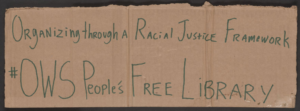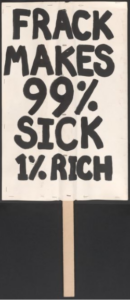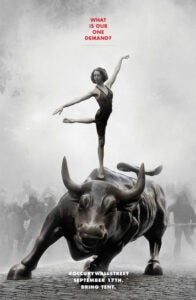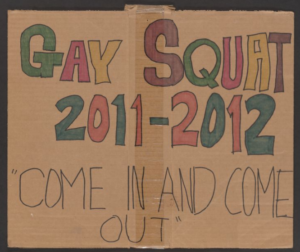DeHart Gender & Occupy Wall Street
DeHart Gender and the Occupy Movement Analysis
Table of Contents / Navigation
Analysis <= You are here!
Goals and Tactics of the Occupy Movement
The Goals of Occupy Wall Street and its sister protests were very diverse as there was an astounding amount of diversity in thought. Some issues are more general than others as some protests had local issues or reference other protests from an earlier point in the year. For example, here is a group of signs from the Occupy Wall Street Archives Working Group Records from NYU’s Tamiment Library and Robert F. Wagner Labor Archives. These signs were all taken from the Occupy Wall Street protest. The first image of the Occupied Wallstreet Journal is interactive.





These are signs from the Occupy Wall Street Archives Working Group Records from NYU’s Tamiment Library and Robert F. Wagner Labor Archives
As can be seen, there are a variety of issues at just the Occupy Wall Street Protest, this lack of a cohesive idea is also a key focus of the movement as everyone there had different ideas or reasons to participate as there are numerous ideas a play, and in the Occupy movement, this created a form of discourse over ideas. [1] With that in mind, this is not like the usual demonstration which has a set and fixed goal, as the goals of occupy as can be seen are very fluid.
The tactics of the Occupy Movement are in the title, Occupation of a space for an indefinite amount of time, generally till they are removed from the location. This is not a novel tactic and has been seen throughout history with such protests like the Tarhir Square in the mentioned Arab Spring from earlier in 2011. Another Protest that used occupation is what Professor Rose is writing on in this publication, the women’s peace camps. For Occupy Wallstreet the main location of focus was already named Zuccotti Park in New York City. This location was chosen, as the original location, the Wall Street Bull, was already blocked off by police. So they instead went to Zuccotti Park a few blocks away due to the police blocking the Bull. [2] The group was trying to take a space that had meaning to the institution, which was Wallstreet, that they wanted to protest against, but they were blocked and regrouped nearby.
Mobilization and what made Occupy Unique.
The entire Occupy Movement is what is considered by Lance Bennett of “The Logic of Connective Action,” as a “Crowd Enabled Connective Action.” [3] In layman’s terms, this protest was not sustained by an Organization, it was sustained by the people through social media. Going back to Fleming’s article, he quoted a leader at Adbusters, “‘We came up with the idea but independent activists just made it their own,'” [4] This is corroborated by the above notion of everyone bringing their ideas to the protest.
Another element that made the protest unique was its online presence. Like with Arab Spring, which is something, some protesters tried to connect during the protest. The online element was critical as it helped the network for the protest to form and reach across the world Social media was a key factor in stitching together the movement through networks like Tumblr and the, at the time, Twitter, through pages and hashtags.[5] These social media components were also all run by individuals or sometimes groups of individuals. [6] This further contributed to the lack of unification behind one idea. This lack of one solid idea is arguably what made Occupy Wall Street so unique, but also led to it’s downfall with minimal effective results. As stated by Calhoun there was a refusal to elect leadership or put together a concise movement statement [7] If a protest like this occurs again, “the next wave of intense mobilization will likely come under a different name.” [8] In agreeance with Calhoun, I feel that it will not be Occupy. Calhoun effectively states that the next Occupy like will be, “sparked by its own exciting innovations, giving voice to new participants and new visions.” [9] in effect, the most unique point is that no movement will ever be another Occupy Wall Street as it was in 2011. In that light it is like the protest equivalent of Woodstock.
Gender and Occupy
Now how does this tie to Gender? Well, let’s look at a landmark near the Wall Street Stock Exchange that was to host the protest and that is a symbol that ties an air of masculinity to the space. The Wall Street Bull, which under the lens of gender is a large Masculine figure that is very much so anatomically correct. According to the article by Pinto from the Tribeca Trib, some very peculiar traditions have evolved involving the statue’s testicles. [10] This obviously adds a gendered air to the space of Wall Street and the whole stock trading world as a whole. The statue represents the robustness of the American market. [11] This is further defined with the common economic terms of bear and bull markets as the symbol of the bear is for the most part depicted as masculine, then the bull is one of the most masculine symbols there is, and the bull is considered a good sign economically. though there is one other element of gender pertaining to the bull, in Adbuster’s initial call to action, they used an image of a female ballerina dancing at the top the bull, which could bring in evocations of the protest trying to strip the space of its masculine energy, said image below.

Now then let’s look up at the images above, in the archive there was only one sign in the online archive that showed anything about gender and that is this one here pertaining to LGBTQ issues.

This is the closest thing to gender that is accessible on the archive. However, I feel that may in fact be fair due to the nature of the protest. Looking at the writings of Jessica Horn in “Gender and Social Movements Overview Report” published in 2013, the writing mentions gender issues that became prevalent in the Occupy Movement and that issue was that, Gender wasn’t seen as an issue from the outset. [12] In Horn’s writing, she claims, “Historically, most progressive social movements have not embraced a commitment to consider gender inequality or challenge patriarchy from the outset.”[13] This was in fact the case for Occupy as the feminists in the crowd had to form their own spaces and caucuses to unify their demands in Occupy as the original space was not open to their ideas. [14] This lack of support can be seen in the lack of online accessible materials with the Occupy Wall Street Archives Working Group Records. Expanding on this the movement was very disjointed in its ideas, and it does look like feminist protestors, had minimal effect on the Narrative of Occupy Wall Street. The reason this claim is made, is due to a lack of support to feminist ideas in the academic discussion of Occupy. This in turn support’s Horn’s claim that Feminists were kept out of the main caucus of ideas for Occupy.[15]
The Safety of Female Protestors (Content Warning: Non Graphic Discussion of Sexual Assault beyond this point)
Alright, this section does have discussion of sexual assault, and I want to make that abundantly clear before I get into this section.
To start this, there is an element to the scholarship that I would like to note, a decent amount of this information comes from Abigail Barefoot’s writing for a Graduate Dissertation titled, “Victim Blaming, Protests, and Public Space: News Coverage of
the Occupy Wall Street Sexual Assaults.” What brought me to this article was the mention of Sexual Assault in the Business Insider video. Abigail’s writes “News coverage of the Occupy Wall Street sexual assaults was more complex than traditional coverage of violence against women. More focus was placed on the violence of the protest itself rather than the women who were sexually assaulted. In this way, the discourse of women protesting in public places was overshadowed by negative ideas about Occupy Wall Street by the press.” [16] This conclusion from Abigail’s writing brings into question the safety of female protesters, which would also lead to the silencing of their ideas in the discussions of the protest. Abigail’s claim that the media is purposefully working to make Occupy seem more dangerous seems valid as the way business insider handled their report. [17] Expanding on this idea, this could have managed to keep women who wanted to participate out of the Occupy movement for fear of this, which is exactly what Abigail is arguing.
Conclusion
In the Grand Scheme, Occupy Wall Street is known for its crowdsourced mobilization and motivation, decentralized network, and lack of cohesion of ideas. This lack of Idea cohesion is what makes the gendered element difficult to see, as women had their own sub-groups in the protest to try to implement feminist ideas into a protest that had no set idea. The main controversy came as there was a legitimate danger to female protesters due to Sexual Assault, which was then used to create fear that would drive women away from physical participation in the protest, thus trying to counter the crowdsourced mobilization. However there is another point that impacted the implementation of Gender into Occupy, and that is the lack of coherent leadership, as even if they could decide on a goal, the anarchism of the protest, would not put it to the front. This is how the protest was formed, everyone there was effectively bringing their own issues to the table and would have to make it their point to share them. In a way that is an element that makes it very adverse to Gender and that is there is no unification behind the ideas as the feminists ended up having to split off. Looking at Occupy as a whole, no movement will truly be a second Occupy, though after it many movements were changed as Occupy showed great success in a grass-roots mobilization through social media.
In-Page Citations
[1] Bennett, W. Lance, The Logic of Connective Action: Digital Media and the Personalization of Contentious Politics. (Cambridge Studies in Contentious Politics, 2013. doi:10.1017CBO9781139198752.) 7
[2] Why Occupy Wall Street Failed 10 Years Ago | Rise And Fall. (Business Insider, YouTube, September 14, 2021.) https://www.youtube.com/watch?v=kGgZvjdaYhg. 2:40-2:50
[3] Bennett, Logic of Connective 149
[4] quoted in Fleming , Andrew. “Adbusters Sparks Wall Street Protest.” Vancouver Courier, September 27, 2011. https://web.archive.org/web/20121011160015/http://www.vancourier.com/Adbusters+sparks+Wall+Street+protest/5466332/story.html.
[5] Bennett, Logic of Connective 162
[6] Ibid
[7] Calhoun, Craig. Occupy wall street in perspective. (British journal of sociology 64, no. 1 (2013): 26-38.) 5
[7] Calhoun, Occupy 2
[8] Ibid
[9] Pinto, Nick. “Bull!” The Tribeca Trib, September 1, 2007. https://web.archive.org/web/20080908014825/http://tribecatrib.com/archives/newssept07/Bull.htm.
[10] Hammond, Gabriella. History of the Charging Bull (and How to See It). (The Wall Street Experience.) Accessed November 26, 2024. https://www.thewallstreetexperience.com/blog/story-behind-legendary-charging-bull/.
[11] Horn, Jessica. Gender and social movements: Overview report. (BRIDGE, Institute of Development Studies, University of Sussex, 2013.) 44
[12] Ibid
[13] Ibid
[14] Ibid
[15] Barefoot, Abigail. Victim Blaming, Protests, and Public Space: News Coverage of the Occupy Wall Street Sexual Assaults (Master’s thesis, Minnesota State University, Mankato. Cornerstone: A Collection of Scholarly and Creative Works for Minnesota State University, Mankato, 2014) 79
[16] Why Occupy Wall Street Failed 10 Years Ago | Rise And Fall. (Business Insider, YouTube, September 14, 2021.) https://www.youtube.com/watch?v=kGgZvjdaYhg. 2:40-2:50 6:11
